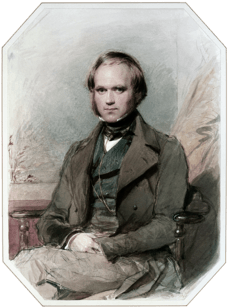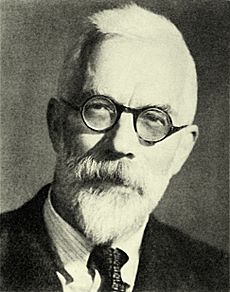Modern evolutionary synthesis facts for kids
The modern evolutionary synthesis is a big idea about evolution. It helped explain how the amazing discoveries of Gregor Mendel fit with Charles Darwin's theory. Darwin's idea was about how living things change over time through natural selection. Mendel found out how we inherit our genes from our parents.
Contents
The Scientists Who Helped
Many important biologists worked together to create this idea. Some of them were Julian Huxley, Theodosius Dobzhansky, Ernst Mayr, Ronald Fisher, J.B.S. Haldane, and Sewall Wright. They helped bring together different areas of biology. These areas included genetics (the study of genes), natural history (studying animals and plants in nature), and paleontology (the study of fossils).
What the Theory Says
The modern synthesis updated Darwin's original ideas. It connected what we know about genetics with what we see in nature.
Here are the main points:
- Evolution can be explained by understanding genetics and observing animals and plants in the wild.
- The different versions of genes (alleles) found in populations are very important for evolution.
- Natural selection is the main way living things change. Even a tiny advantage can become very important over many generations. Animals and plants in the wild have a "struggle for existence." Only those that survive and reproduce pass their genes to their children. Scientists found that natural selection in the wild is even stronger than Darwin thought.
- Evolution usually happens slowly. Small genetic changes build up over time. Species change little from one generation to the next. Big changes can happen, but they are very rare.
- Genetic drift is usually less important than natural selection. Genetic drift is when gene frequencies change by chance, especially in small groups of living things.
- In paleontology, we study how fossils have changed over time. We believe the same things that cause change today also happened in the past.
- The speed of evolution can change. It might get faster or slower depending on the environment. But the reasons for evolution stay the same.
The idea that new species form when groups of living things become separated has been discussed a lot. Being separated by geography often leads to new species forming. In plants, a process called polyploidy (having extra sets of chromosomes) is also important for new species to appear.
One way some biologists see this idea is: "Evolution is mostly about changes in how often different versions of genes appear from one generation to the next."
Even though parts of the synthesis have been questioned, it was a huge step forward in understanding evolution. It cleared up many confusing ideas. It also encouraged a lot of new research after WWII.
Discoveries After the Synthesis
Since the modern synthesis, many new discoveries have been made in earth sciences and biology. Here are some important ones that connect to evolution.
Understanding Earth's History
The Earth is where evolution happens. Darwin studied evolution with the geology ideas of his time. But now we know much more about Earth's long history.
- The age of the Earth is now thought to be about 4.56 billion years old. That's about one-third of the age of the universe! The time when most animal life appeared, called the Phanerozoic eon, is only the last ninth of Earth's history.
- The idea of continental drift by Alfred Wegener became widely accepted around 1960. This led to the idea of plate tectonics. This means the Earth's outer layer is made of huge plates that move slowly. This discovery helps explain things like volcanos, earthquakes, and how mountains form. It also helps us understand ancient paleogeographical maps.
- We now understand more about how the Earth's atmosphere changed. Oxygen replaced carbon dioxide in the air during the Proterozoic eon. This was likely caused by tiny living things called cyanobacteria. Their colonies formed stromatolites (layered rock structures). This increase in oxygen led to the evolution of organisms that use oxygen (aerobic organisms). It also caused the first big ice ages.
- Geologists found the first widely accepted fossils of tiny life forms. These rocks are about 3.465 billion years old. A geologist named Walcott was one of the first to find ancient bacteria fossils. He also thought stromatolites were from living things. His ideas were not accepted then, but now we see how important his discoveries were.
- We have more and more information about ancient climates. For example, huge ice ages happened in the Proterozoic after carbon dioxide in the atmosphere dropped. These ice ages lasted a very long time. They caused a big drop in tiny plant life. You can learn more about the Cryogenian period and Snowball Earth.
- Catastrophism and mass extinctions. Scientists now agree that big, sudden events have happened. These events, like mass extinctions, have greatly influenced evolution. Extinction events disrupt life and can remove dominant species. This allows other groups to rapidly evolve and spread out (adaptive radiation). Causes include meteorite strikes (like the one that ended the dinosaurs, the K–T event). Also, huge volcanic eruptions (like the Deccan Traps or Siberian Traps) have caused extinctions.
These discoveries about Earth's history show that large-scale events have shaped macroevolution and megaevolution. These terms mean evolution above the species level. This includes mass extinctions, adaptive radiations, and major changes in life forms.
Amazing Fossil Discoveries
In the last 30 years, many new fossil sites have been explored. Also, older fossils are being looked at with new eyes. Many incredible discoveries have been made that help us understand evolution better.
- The Jehol biota was discovered in China. This included dinobirds and early birds from the Lower Cretaceous period. These fossils clearly show that birds evolved from coelurosaurian theropod dinosaurs.
- Studies on early four-legged animals (tetrapods) from the Upper Devonian period.
- The early stages of whale evolution have been found. These fossils show how whales moved from land back to the ocean.
- The evolution of flatfish (like plaice, sole, turbot, and halibut) is now better understood. Young flatfish are perfectly symmetrical. But as they grow, one eye moves to the other side of their head! Some species have both eyes on the left side, others on the right. All living and fossil flatfish have one "eyed" side and one "blind" side. Darwin thought the eye must have moved slowly over time. Recent studies of Eocene fossil flatfish show this happened gradually. The intermediate forms were able to survive well. This example fits perfectly with the modern evolutionary synthesis.
Evo-devo: How Life Builds Itself
New work in genetics has led to a fresh way of looking at how animals develop. This field is called evolutionary developmental biology, or evo-devo for short.
Scientists have found clear proof that special genetic systems control much of how an animal develops. These systems involve hox genes. In his Nobel Prize speech, E.B. Lewis said that comparing these control genes across different animals should show how both the animals and their control genes have evolved.
Many scientific journals have dedicated issues to evo-devo. This shows how important this field is. It helps us understand how new features and body shapes have appeared during evolution.
Relevant pages






